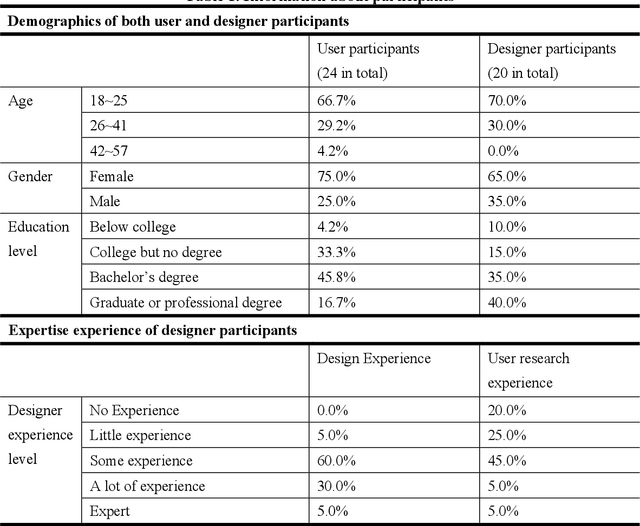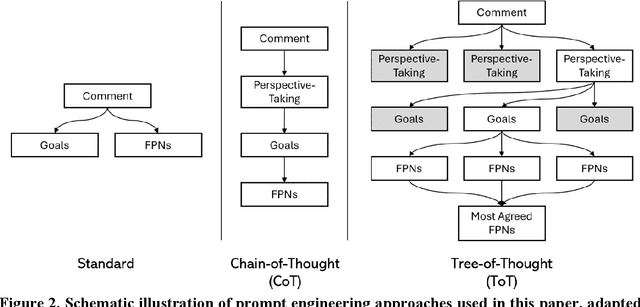Leah Chong
Prompting for products: Investigating design space exploration strategies for text-to-image generative models
Jul 22, 2024Abstract:Text-to-image models are enabling efficient design space exploration, rapidly generating images from text prompts. However, many generative AI tools are imperfect for product design applications as they are not built for the goals and requirements of product design. The unclear link between text input and image output further complicates their application. This work empirically investigates design space exploration strategies that can successfully yield product images that are feasible, novel, and aesthetic, which are three common goals in product design. Specifically, user actions within the global and local editing modes, including their time spent, prompt length, mono vs. multi-criteria prompts, and goal orientation of prompts, are analyzed. Key findings reveal the pivotal role of mono vs. multi-criteria and goal orientation of prompts in achieving specific design goals over time and prompt length. The study recommends prioritizing the use of multi-criteria prompts for feasibility and novelty during global editing, while favoring mono-criteria prompts for aesthetics during local editing. Overall, this paper underscores the nuanced relationship between the AI-driven text-to-image models and their effectiveness in product design, urging designers to carefully structure prompts during different editing modes to better meet the unique demands of product design.
CAD-Prompted Generative Models: A Pathway to Feasible and Novel Engineering Designs
Jul 11, 2024



Abstract:Text-to-image generative models have increasingly been used to assist designers during concept generation in various creative domains, such as graphic design, user interface design, and fashion design. However, their applications in engineering design remain limited due to the models' challenges in generating images of feasible designs concepts. To address this issue, this paper introduces a method that improves the design feasibility by prompting the generation with feasible CAD images. In this work, the usefulness of this method is investigated through a case study with a bike design task using an off-the-shelf text-to-image model, Stable Diffusion 2.1. A diverse set of bike designs are produced in seven different generation settings with varying CAD image prompting weights, and these designs are evaluated on their perceived feasibility and novelty. Results demonstrate that the CAD image prompting successfully helps text-to-image models like Stable Diffusion 2.1 create visibly more feasible design images. While a general tradeoff is observed between feasibility and novelty, when the prompting weight is kept low around 0.35, the design feasibility is significantly improved while its novelty remains on par with those generated by text prompts alone. The insights from this case study offer some guidelines for selecting the appropriate CAD image prompting weight for different stages of the engineering design process. When utilized effectively, our CAD image prompting method opens doors to a wider range of applications of text-to-image models in engineering design.
Reading Users' Minds from What They Say: An Investigation into LLM-based Empathic Mental Inference
Mar 20, 2024



Abstract:In human-centered design, developing a comprehensive and in-depth understanding of user experiences, i.e., empathic understanding, is paramount for designing products that truly meet human needs. Nevertheless, accurately comprehending the real underlying mental states of a large human population remains a significant challenge today. This difficulty mainly arises from the trade-off between depth and scale of user experience research: gaining in-depth insights from a small group of users does not easily scale to a larger population, and vice versa. This paper investigates the use of Large Language Models (LLMs) for performing mental inference tasks, specifically inferring users' underlying goals and fundamental psychological needs (FPNs). Baseline and benchmark datasets were collected from human users and designers to develop an empathic accuracy metric for measuring the mental inference performance of LLMs. The empathic accuracy of inferring goals and FPNs of different LLMs with varied zero-shot prompt engineering techniques are experimented against that of human designers. Experimental results suggest that LLMs can infer and understand the underlying goals and FPNs of users with performance comparable to that of human designers, suggesting a promising avenue for enhancing the scalability of empathic design approaches through the integration of advanced artificial intelligence technologies. This work has the potential to significantly augment the toolkit available to designers during human-centered design, enabling the development of both large-scale and in-depth understanding of users' experiences.
 Add to Chrome
Add to Chrome Add to Firefox
Add to Firefox Add to Edge
Add to Edge